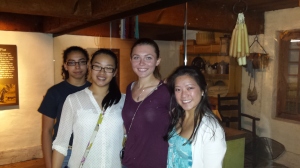
From Madame Newton and Madame Clem:
We want to thank the students for their outstanding maturity and manners during the field trip, you were AWESOME! Also a special to Anne Marie Badke for her vision and generosity in making this trip a reality.
The first European inhabitants of Detroit were French people. Cadillac, a French explorer, was the founder of Detroit. Of course, the Ottawa, the Chippewa, and the Potawatomi were already in this area before the French came in 1701. Cadillac was granted permission by the King of France to come to Detroit to establish a fur trading post. Generally, the French had good relationships with the Native Americans.

Beginning in 1707, Cadillac began granting land on both sides of the Detroit River to French settlers who wanted to farm as well as hunt for beaver and fish. Because transportation was important, every farmer wanted to have land right on the Detroit River and near Fort Ponchartrain. Each farmer was given land on the river front which followed the shore line for two hundred to one thousand feet and extended from the Detroit River back two or three miles. Because the lands were long and narrow, they were called “ribbon farms.” The ribbon farms lined both sides of the Detroit River from Ecorse up to Lake St. Clair. The farmers could use their canoes on the Detroit River to visit other farmers and friends in Fort Ponchartrain and to take their farm products and furs to market. Also, the nearby Fort provided them with security and safety. When Cadillac granted the land to farmers, they had to agree upon certain things. The farmer could trade, hunt and fish on his property, however, the farmer was required to pay rent for the use of land and a fee for trading privileges. Also, he had to pay still another fee to Cadillac for the use of his mill for grinding corn and other grains that he grew on the farm. The farmer could fish in the Detroit River and hunt on his land for deer, beaver, wild ducks, pheasants and other animals. They used the meat for food and traded furs. The farmers grew corn wheat and vegetables and some of them had cattle, pigs and a few horses. The French farmers also had orchards, where they grew pears, apples and other fruits. The entire family worked on the farmland and made the things they needed. The housewives baked bread in outdoor ovens made of clay, made their own cloth and sewed their own clothes. They were able to trade with the Native Americans to get maple sugar and other things they needed or wanted. In the evenings, when work was done, the habitants of Detroit enjoyed spending time together. In the summer they played outdoor games and raced carts. In the winter months, they rode sleighs up and down the frozen Detroit River. They also played games, like checkers and cards. On Sundays they gathered at Ste. Anne’s Church for Catholic services. Today some of the streets in Detroit have names of the original French farmers. Beaubien, St. Aubin, Chene and Livernois Avenues are just a few of the streets named after the early French farmers and settlers.
